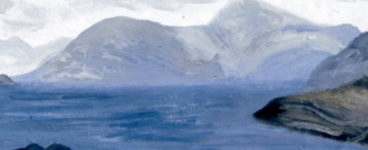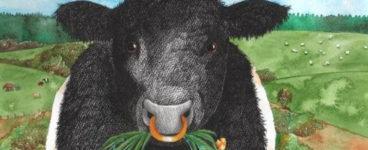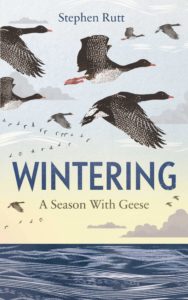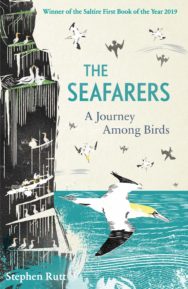‘Seabirds love islands, as I love islands: the further out of the way they are, the less disturbance there is, the more perfect they are.’
Stephen Rutt moved to the Solway Firth in 2018, and wrote about the geese there in his book Wintering: A Season with Geese. Before he moved to the South-West of Scotland, he travelled the country charting sea birds and wrote of the experience in his Saltire-winning book, The Seafarers: A Journey Among Birds. To celebrate the release of the paperback of The Seafarers, we share an extract here for you to enjoy.
Extract taken from The Seafarers: A Journey Among Birds
By Stephen Rutt
Published by Elliot & Thompson
Birds were my awakening to the world outside. Birding teaches you to be aware of subtle distinctions that signify differences. Whether it was the leg colour or a few millimetres’ difference in wing length that enabled me to tell two common warblers apart, or the presence of a wing-bar that revealed it to be extremely rare. Whether I was standing in an overgrazed field, a set-aside field or a meadow rich in life that an owl would soon fly over through the thick light of dusk. Whether the wind in October was coming from the north and my day out would be cold and boring, or whether it was coming from the east and it would be cold and rich in potential. It made me pay attention, not just to these things, but to how and when they change. Whether my first swallow of the year was in March or May – and why. Birding forces you to pay attention to the world as it happens around you and gives you a way of decoding it.
Before I became a birder, I was briefly a fisherman. While sitting behind a rod, fruitlessly waiting, I never thought about global warming, the rise in sea levels, or how the algae in the bay of the lake might be caused by the run-off of unpronounceable agrochemicals with startling side effects. Fishing taught me futility – that things will probably not go your way. Birding taught me to look at and think about the outside world, to engage with the landscape and all it holds.
There is a gentle art to birding. By which I mean there is no correct way to do it. You can go outside for days or just glance out of a window, notice something, and carry on, your day having become slightly wilder, slightly more interesting than it might otherwise have been. It requires no basic equipment other than your own senses and a desire to notice and to know. Birding makes no demands of you other than these. It is gentle because you can’t force it. It is more productive not to, better to slow down to the speed of the landscape and blend with it. It is an art because there is no set route, no magic key to finding or knowing a bird. To recognise one requires a myriad of moment-specific considerations. And much of it can be done by intuition – the application of experience – rather than rules. You never stop learning. It can open you up to things either extraordinarily beautiful or extraordinarily depressing.
Being a teenager enabled me to be obsessed without shame. I absorbed the Collins field guide to the birds of Europe. Then Sibley’s field guide to American birds. Then the monographs to specific families of birds, then specific species. I absorbed site guides, built a mental map of the world’s birds, read blogs, dissected forums. I found a network of others from across Europe and we spent evenings indoors, online, talking about mornings outdoors. We were captivated by the Scottish islands. I had never been but, from the photos I had seen and the books I had read, I constructed my own mythic version of them: quiet, solitary utopias, places where one could not ignore nature, and if one tried then nature would come and find you. Come and rattle at the windowpanes, or land in your garden, or squat on your car bonnet, until you were forced to pay attention again. A place for the inveterately shy.
*
To understand the appeal of a seabird, it’s necessary to explore what a seabird is, and what it isn’t. Most birds migrate, most will cross a sea. They are not seabirds, not any more than a seabird becomes a landbird when it sets up residence on a cliff to breed every summer.
A scientist’s definition might focus on how they have feathers covering their auditory canal, to prevent water entering their ears when they dive for food, or to prevent flying with muffled hearing, or – more likely – to minimise the effects of pressure. Another scientist’s definition might focus on the Procellariiformes: the order that contains the petrel, shearwater and albatross families. They have a tubenose: a prominent bulging nostril above the bill, an adaptation specific to these families, allowing them to smell food on a sea breeze and expel the salt from their exposure to saltwater. But this would be partial definition. It would not include the auks, gannets, gulls, skuas, terns and eiders – all of which are predominantly found, or should be found, on the edge. Some might focus on their power of smell, unusually highly developed in some seabirds, while most other birds cannot smell particularly well. The problem is that all definitions of a seabird are partial. Most would exclude the eider. They might live on the coast, but they feed at sea. It is the sea that defines them and their capacity for coping with it makes them difficult, makes them wild, makes them captivating. The ‘should be found’ is important here – though some birds always end up lost, things are changing on this front. Some are moving inland.
Seabirds live predominantly out to sea – feed at sea, sleep at sea, and experience a habitat that is simultaneously as vast as the ocean and as small as the gap between two waves. Seabirds are mysterious. Away from islands, they are usually seen from land only when summer storms push across the Atlantic and sweep them towards the ocean’s edges. Seabirds love islands, as I love islands: the further out of the way they are, the less disturbance there is, the more perfect they are. All use them to breed – an act of convenience – though the vast majority occupy tiny cliff ledges, several hundred metres above the sea. It’s technically land, but I wouldn’t want to stand there.
Seabirds are transient, fleeting, remote things – yet they are also moving into towns and cities. When they are written about, they reveal a good deal about the author. As with all animals, they are good subjects on which to project human desire. Seabirds are some of our most loved and hated species. They inspire religious devotion or revolutionary zeal. Hermitic living or the hectic crowd. They are symbols of revolution, pirates and victims. They are bounteous and declining – and, like almost everything symbolic of the remote and wild, they are deeply touched by human activity: pollution, over-fishing, the warming of the seas.
Stephen Rutt has been commissioned to write a short book, The Saltmarsh Library by the Wigtown Festival as part of Scottish Natural Heritage’s Year of Coasts and Waters. It will be published in the Spring of 2021 and forms the focal point of Wigtown’s ongoing activity outwith the festival. You can find out more on the Wigtown website.
The Seafarers: A Journey Among Birds by Stephen Rutt is published by Elliot & Thompson, priced £9.99
ALSO IN THIS ISSUE

 Gavin Maxwell’s Ring of Bright Water
Gavin Maxwell’s Ring of Bright Water
‘Into this bright, watery landscape Mij moved and took possession with a delight that communicated i …

 All Hail Curly Tale!
All Hail Curly Tale!
‘After all, without our fabulous rural landscapes there would be no stories to tell! ‘














